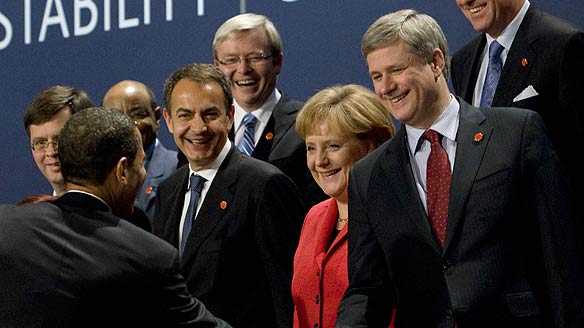For the foreseeable future, further reduction of the protection of currently sensitive products will require negotiations.
On the other hand, seizing many opportunities to reduce costs or risks of international commerce do not require negotiations, since they are already perceived to be positive-sum games, leading to cooperative arrangements which are in the interest of all those involved. Practical examples include the many opportunities to improve the efficiency and security of supply chains, with potentially huge economic returns to all the economies involved.
It should be possible to have a logical division of effort between APEC, a voluntary process of cooperation, and the WTO in the Asia Pacific, with the WTO dealing with those issues that do need to be negotiated and APEC dealing with the many other issues where negotiations are not needed. At present, there is no such division of effort.
It will be difficult to achieve this while the attention of APEC leaders is distracted by the false hope of an APEC-wide discriminatory trading arrangement. In the longer term, an efficient division of labour could emerge between the G20 and the WTO, if the G20 can achieve both momentum and legitimacy.
The G20 process could rise to this challenge, provided it can gain momentum and legitimacy – that, of course, remains to be seen. There is hope that the G20 can become an ongoing process, which could help solve the current short-term global financial crisis and the associated temptation to flirt with protectionism. G20 leaders could then address other looming problems such as climate change. Then it may be possible to move on to promoting global economic integration.
The G20 will be a voluntary process of cooperation. As in the first two meetings, any agreements to coordinate policies will be based on consensus. At the same time, a consensus among such an influential group of economies and governments can be expected to lead to agreements in international bodies, including the WTO, which are designed to reach binding undertakings.
It may be possible for the G20 to promote economic integration, in line with the comparative advantage of it and the WTO, using the WTO to address issues where negotiations are needed and promoting voluntary cooperation on the many issues where negotiations are not needed. In the near future, G20 leaders can help to complete the Doha Round.
As a voluntary process of cooperation among very diverse economies, the G20 could draw on the experience of APEC to address the many opportunities to promote further economic integration among their economies, and the rest of the world where it is not necessary to rely on negotiations.
G20 leaders could begin by assessing whether some of the successes of APEC in facilitating trade and investment could be extended to a wider geographic area. Over time, the G20 could help to complement a world of already low border barriers to trade and investment by providing an environment of transparency, best practice, and consistency of regulations, including competition policy, regulations on government procurement, mutual recognition of standards and qualifications; efficient communications, including e-commerce; and best practice logistics.
To a large extent, creating such an environment among diverse economies involves helping those that want to adapt current best practice by sharing information, experience, expertise and technology. Best practice will continue to evolve, so there will always be scope for such cooperation. Not all G20 economies will act simultaneously on particular issues as not all of them may be able to adopt the required measures at the same time. However, some can set positive examples for others.
Such a ‘pathfinder’ approach can be adopted by the G20. That would make it possible for some G20 economies to pioneer potentially global co-operative arrangements to promote economic integration. Based on the achievements of APEC in terms of trade facilitation, the APEC participants in G20 can be early pathfinders.
APEC governments which have implemented harmonisation and other measures to improve their customs procedures could encourage other economies, including other G20 economies, to adopt similar measures, sharing the information, experience, expertise and technology to help them to so. In the longer term, some or all G20 economies could act as pathfinders for the rest of the world.
If G20 economies implement practical arrangements to reduce the costs and risks of international commerce among them, others will be interested in joining such cooperative arrangements to facilitate trade.
This is a summary of the latest EABER Newsletter, which is available here.


Despite the fact of the existence of a broader range in institutional establishments on trade and finance, the interregional trade and capital flows in the East Asia Smmit region/Asian+3+Cer have increased steadily. To accelerate the establishment of EAS regional economic integration, the following measures seem necessary:
1.improvements of trade and financial facilitation in this region, particularly in the developing economies of this region.
2.The establishment of EAS FTA of Bangkok Agreement its negotiatiion has to be initiated. Any negotiation based on bilateral or sub region have to be stop, and all efforts must be concentrated on the negotiation of an EAS/ASEAN+3+CER FTA.
3.The CMI/Chiang Mai Intiatve with its $120 billion capitalisation could be considered as the embryo of a future EAS central Bank. What we have to agree on now may be a ten years program to control the fluctuation of any currency in the EAS region: precisely what the European Union did before the establishment of the Euro. Australia and New Zealand may add to the CMI’s funds. The CMI Fund can be used to help member country to manage currency fluctuation. By the end of ten years we expect there will be one or two potential OCA/Optimum Currency Area in the EAS region.
4.The aforesaid action is a prerequsite for having sustainable regional economic integration.